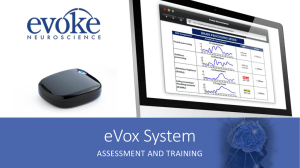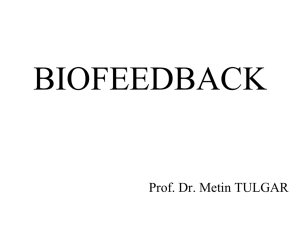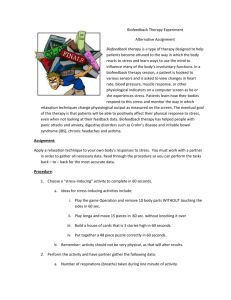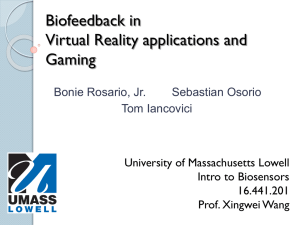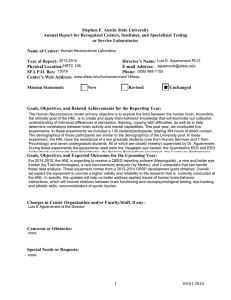EEG BIOFEEDBACK IN THE SCHOOLS in a School Setting ISNR Copyrighted Material
advertisement
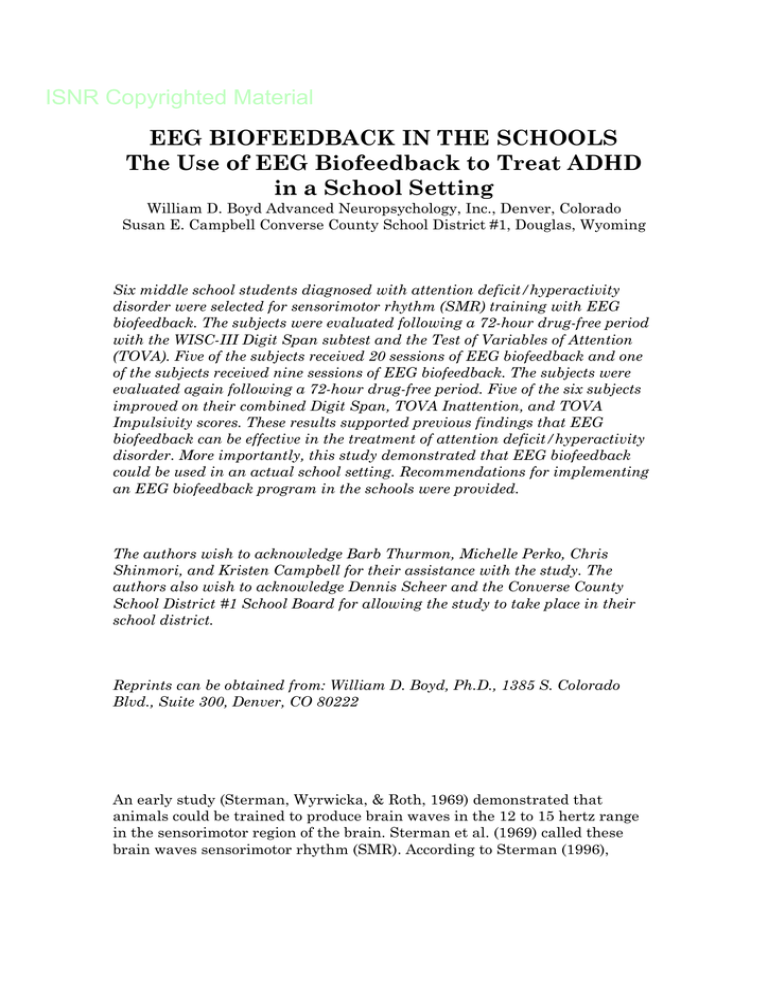
ISNR Copyrighted Material EEG BIOFEEDBACK IN THE SCHOOLS The Use of EEG Biofeedback to Treat ADHD in a School Setting William D. Boyd Advanced Neuropsychology, Inc., Denver, Colorado Susan E. Campbell Converse County School District #1, Douglas, Wyoming Six middle school students diagnosed with attention deficit/hyperactivity disorder were selected for sensorimotor rhythm (SMR) training with EEG biofeedback. The subjects were evaluated following a 72-hour drug-free period with the WISC-III Digit Span subtest and the Test of Variables of Attention (TOVA). Five of the subjects received 20 sessions of EEG biofeedback and one of the subjects received nine sessions of EEG biofeedback. The subjects were evaluated again following a 72-hour drug-free period. Five of the six subjects improved on their combined Digit Span, TOVA Inattention, and TOVA Impulsivity scores. These results supported previous findings that EEG biofeedback can be effective in the treatment of attention deficit/hyperactivity disorder. More importantly, this study demonstrated that EEG biofeedback could be used in an actual school setting. Recommendations for implementing an EEG biofeedback program in the schools were provided. The authors wish to acknowledge Barb Thurmon, Michelle Perko, Chris Shinmori, and Kristen Campbell for their assistance with the study. The authors also wish to acknowledge Dennis Scheer and the Converse County School District #1 School Board for allowing the study to take place in their school district. Reprints can be obtained from: William D. Boyd, Ph.D., 1385 S. Colorado Blvd., Suite 300, Denver, CO 80222 An early study (Sterman, Wyrwicka, & Roth, 1969) demonstrated that animals could be trained to produce brain waves in the 12 to 15 hertz range in the sensorimotor region of the brain. Sterman et al. (1969) called these brain waves sensorimotor rhythm (SMR). According to Sterman (1996), ISNR Copyrighted Material "Spontaneous SMR is seen during motor response inhibition and sustained motor quiescence in an otherwise alert animal. Voluntary production of the SMR, therefore, requires the animal to effectively stabilize or suppress somatosensory proprioceptive input while remaining generally attentive." (p. 14) The motor response inhibition and sustained motor quiescence noted by Sterman (1996) were precisely the kinds of behaviors educators wish to see develop in children who are diagnosed with attention deficit/hyperactivity disorder. Since the Sterman et al. (1969) study, researchers have been interested in applying electroencephalographic (EEG) biofeedback technology to the treatment of humans with attention deficit/hyperactivity disorders. Lubar & Shouse (1976) used EEG biofeedback of SMR to treat a child with an attention deficit/hyperactivity disorder. Since this early work, there have been a number of studies that have successfully applied EEG biofeedback to the treatment of attention deficit/hyperactivity disorders (Lubar, 1991; Lubar, 1993; Lubar & Lubar, 1984; & Tansey, 1993). Rossiter & LaVaque (1995) found that 20 EEG biofeedback sessions were sufficient to significantly reduce the number of cognitive and behavioral symptoms of attention deficit/hyperactivity disorder. They concluded that EEG biofeedback can lead to "normalization" of behavior, "and can enhance the long-term academic performance, social functioning, and overall life adjustment of the AD/HD patient." (p. 25) Sterman, Goodman, & Kovalesky (1978) and Othmer, Othmer, & Marks (1991) demonstrated that the effects of SMR training through EEG biofeedback could have long-lasting effects. Most of the EEG biofeedback studies were completed in clinical settings where extraneous variables could be effectively controlled. The purpose of this study was to apply EEG biofeedback technology in an actual school setting with all of the inherent problems, issues, and distractions that are likely to occur in such a setting. Ó»¬¸±¼ Subjects ISNR Copyrighted Material The subjects included six middle school students of the Converse County School District #1 in Douglas, Wyoming. The subjects were all males who ranged in age from 13.0 to 15.0 years. Two subjects were in the sixth grade, one was in the seventh grade, and three were in the eighth grade. The subjects were all diagnosed with an attention deficit/hyperactivity disorder and had been treated or were currently being treated with a psychostimulant medication such as Ritalin. Selection criteria included a diagnosis of attention deficit/hyperactivity disorder and likely parental cooperation. Ó»¿-«®»- Quantitative Electroencephalogram (qEEG) Lexicor Neurosearch 1600 brain wave analyzer was used to complete a quantitative electroencephalogram (qEEG) evaluation on each subject. Nineteen active electrodes were placed in a 10 20 montage with the help of an Electrocap. The electrodes were grounded to the forehead and referenced to the ears. At least 300 seconds of brain wave activity was collected while the subjects were relaxed with eyes closed. The resulting two-second brain wave epochs were examined and epochs containing significant muscle activity or eye movement artifacts were eliminated. In each case, at least 30 seconds of relatively artifact-free brain wave activity was available for the analyses. Comparison of the subjects brain waves to a database of normal brain waves (Thatcher, Walker, Gerson, & Geisler, 1989) suggested that a treatment protocol designed to increase the amplitude of 12 to 15 hertz brain wave activity in the sensorimotor region was appropriate. That is, there were no other significant brain wave abnormalities that might account for the diagnosis of an attention deficit/hyperactivity disorder. Wechsler Intelligence Scale for Children – III (WISC-III) Digit Span Subtest An educational diagnostician administered the Digit Span subtest of the Wechsler Intelligence Scale for Children III. The Digit Span subtest score was converted to a standard score with an average of 100 and standard deviation of 15 in order to facilitate comparison with other test scores. ISNR Copyrighted Material Test of Variables of Attention (TOVA) The TOVA (Greenberg & Kindschi, 1996) is a continuous performance test that is sensitive to problems in attention and impulsivity. The subjects were required to watch a video screen and press a button when a target stimulus was presented and inhibit pressing the button when a non-target stimulus appeared. The standard scores (mean of 100 and standard deviation of 15) from the Inattention (errors of omission) and Impulsivity (errors of commission) scales were obtained. Ю±½»¼«®» Pretest The subjects were evaluated following a 72-hour drug-free period. After the qEEG evaluations were completed, the subjects were administered the WISCIII Digit Span subtest and the TOVA. The standard scores from the Digit Span subtest, the Inattention Scale of the TOVA, and the Impulsivity Scale of the TOVA were added together and divided by three in order to obtain a combined standard score. Ì®»¿¬³»²¬ An active electrode was placed on the scalp above the sensorimotor region of the brain (CZ). A Lexicor Pod II Trainer was programmed to provide visual and auditory feedback of 12 to 15 hertz brain wave activity. Five of the six subjects received twenty 30-minute sessions of EEG biofeedback training. The sixth subject only received nine sessions due to school absences and problems with motivation. Posttest The posttest evaluation took place following a 72-hour drug-free period. The subjects were again administered the WISC-III Digit Span subtest and the ISNR Copyrighted Material TOVA. The standard scores from these tests were again averaged to obtain a combined standard score. λ-«´¬- Five of the six subjects improved from the pretest to the posttest in their combined standard scores. The TOVA results for the sixth subject were invalid, but there was a mild improvement in the Digit Span score. Table 1 presents the combined scores from pretest to posttest and amount of change. The probability of these results occurring by chance alone was less than one in 1000. Table 1. Combined Digit Span, Innattention, and Impulsivity Scores Subjects S1 S2 S3 S4 S5 S6 Pretest scores 96.7 96.3 94.7 100 102.7 Invalid Posttest scores 109.7 102.7 99 101.7 104.3 Invalid Differences 13 6.4 4.3 1.7 1.6 Invalid Only the results of the Digit Span subtest were available for all six subjects, so a statistical analysis was also performed on these scores (see Table 2). The difference between these pretest scores and posttest scores should only occur six out of 100 times by chance alone. Table 2: WISC-III Digit Span Subtest Scores Subjects S1 S2 S3 S4 S5 S6 Pretest scores 100 75 75 85 90 75 Posttest scores 105 110 95 90 95 80 Differences 5 35 20 15 5 5 Ü·-½«--·±² The results of this study supported previous findings that EEG biofeedback can be used to treat attention deficit/hyperactivity disorders. In this study, ISNR Copyrighted Material five out of six subjects clearly benefited from treatment. Othmer (1994) said that 20 EEG biofeedback sessions can successfully treat approximately 30% of subjects with attention deficit/hyperactivity disorders, but the current study resulted in positive gains for at least 80% of the subjects. Neither the pretest nor the posttest data from the TOVA was valid for one of the subjects. This subject began responding randomly following the second quarter of the test, which suggested that he "gave up" during the test. In addition to giving up during the TOVA, this subject was noted to have a very flat affect. An interview with the subjects mother suggested that there had been an increase in irritability, unhappiness, appetite problems, and sleeping problems during the past few months. The impression was that this subject was suffering from a major depressive disorder and he was referred to his physician for further evaluation and treatment. It was interesting to note that this subject improved in his Digit Span subtest score during which he did not "give up." Perhaps this subject would also have improved in his TOVA scores if the results were not invalid due to a random response pattern in the second half of the test. A decrease in the TOVA Inattention score was noted between the pretest and the posttest for two subjects (S2 and S3). After missing the first few items of the TOVA, S2 asked, "Am I supposed to press the button when the square is at the bottom or at the top?" After clarifying that the target contained the square at the top S2 missed no other items. Thus, it seemed very likely that this subject would have improved on all measures if he had thoroughly understood the task before beginning the TOVA. This same subjects Digit Span subtest score improved from 75 to 110. Interestingly, this was the same subject who only completed nine EEG biofeedback sessions. The reason for the increased TOVA omission errors for S3 was not known, but a such a decrease in a test score can occur as a result of chance factors due to the number of tests administered. The importance of the current study was not to simply replicate previous findings. The present study had far too few subjects and lacked the scientific controls necessary to serve as a cross-validation study for EEG biofeedback in the treatment of attention deficit/hyperactivity disorders. The real value of the present study was to demonstrate the effective use of EEG biofeedback in an actual school setting. ISNR Copyrighted Material There were many problems encountered during the implementation of this study. A computer problem made it necessary to transport both the computer and the POD II trainer from place to place in order to provide treatment. Fortunately, most of the treatment took place in the same building. The scheduling of subjects and staff so that the EEG biofeedback training could be completed in a timely manner was the second major problem. The project did not begin until late in the school year and only one of the subjects was able to complete all 20 sessions before the summer break. As a result, five of the six subjects had to complete their training during the summer months. Motivation was a third major barrier, particularly for one of the subjects. Movie passes had to be used to "encourage" the subject to participate in the program during the summer. Even with bribery, this subject was only able to complete nine sessions. Incidentally, this subject made good improvements as a result of his rather brief treatment. The fourth problem resulted from staff changes and personnel issues. At first, the special education director and a diagnostician were to be responsible for providing the EEG biofeedback to the subjects. This turned out to be a problem due to the many other responsibilities of these individuals. A decision was made to train a college student as the technician who would provide treatment. Still another paraprofessional had to be trained because the college student returned to school before the program was completed. On the positive side, studies have shown EEG biofeedback to be an effective alternative to the use of psychostimulant medication for many children diagnosed with attention deficit/hyperactivity disorders. It is non-evasive and has few, if any, side effects. It is relatively easy for the trainer and the child to do, although there is a risk of boredom on the part of both. It can be relatively inexpensive when it is made a regular part of the subjects special education program. ISNR Copyrighted Material Recommendations for the use of EEG biofeedback in the schools: Make sure the equipment is going to work before beginning treatment. Make sure that the EEG biofeedback sessions are a regular part of the subjects weekly schedule of activities. This can be accomplished by scheduling the treatment once per week or by rotating the treatments with other activities. Make sure there are a sufficient number of trained technicians. Also, make sure that the technicians other responsibilities will not interfere with providing EEG biofeedback treatment to subjects. Select appropriate subjects through the typical interdisciplinary process for developing individualized educational plans. Enlist the support of parents and teachers and provide plenty of education concerning EEG biofeedback training. Obtain the support of the subjects personal physicians. Use other strategies in addition to EEG biofeedback to treat the attention deficit/hyperactivity disorder. This might include behavior modification, environmental modification, and even the use of smaller doses of psychostimulant medications. In conclusion, the use of EEG biofeedback in schools can provide an effective alternative to psychostimulant medications. EEG biofeedback can become part of the students scheduled weekly activities so that there is little or no interference with other educational activities. λº»®»²½»Greenberg, L. M., & Kindschi, C. L. (1996). Test of Variables of Attention: Clinical Guide. California: Universal Attention Disorders. Lubar, J. F. (1991). Discourse on the development of EEG diagnostics and biofeedback for attention-deficit/hyperactivity disorders. Biofeedback and Self-Regulation, 16, 202-225. ISNR Copyrighted Material Lubar, J. F. (1993). Innovation or inquisition: The struggle for ascent in the court of science: Neurofeedback and ADHD. Biofeedback, 21, 23-30. Lubar, J. O., & Lubar, J. F. (1984). Electroencephalographic biofeedback of SMR and beta treatment of attention deficit disorders in a clinical setting. Biofeedback and Self-Regulation, 9, 1-25. Lubar, J. F., & Shouse, M. N. (1976). EEG and behavioral changes in a hyperkinetic child concurrent with training of the sensorimotor rhythm (SMR): A preliminary report. Biofeedback and Self-Regulation, 3, 293-306. Othmer, S. (1994). A discussion of alpha/theta training and SMR/beta training and their respective roles. (Available from EEG Spectrum, Inc., 16100 Ventura Blvd., Suite 10, Encino, CA 91436) Othmer, S., Othmer, S. F., & Marks, C. S. (1991). EEG biofeedback training for attention deficit disorder, specific learning disabilities, and associated conduct problems. (Available from EEG Spectrum, Inc., 16100 Ventura Blvd., Suite 10, Encino, CA 91436) Rossiter, T. R., & LaVaque, T. J. (1995). A comparison of EEG biofeedback and psychostimulants in treating attention deficit hyperactivity disorders. Journal of Neurotherapy, 3, 48-59. Sterman, M. B. (1996). Physiological origins and functional correlates of EEG rhythmic activities: Implications for self-regulation. Biofeedback and SelfRegulation, 21 (1), 3-33. Sterman, M. B., Goodman, S. J., & Kovalesky, R. A. (1978). Effects of sensorimotor EEG feedback training on seizure susceptibility in the rhesus monkey. Experimental Neurology, 62, 735-747. Sterman, M. B., Wyrwicka, W., & Roth, S. R. (1969). Electrophysiological correlates and neural substrates of alimentary behavior in the car. Annals of the New York Academy of Science, 157, 723-739. ISNR Copyrighted Material Tansey, M. A. (1993). Ten-year stability of EEG biofeedback results for a hyperactive boy who failed fourth grade perceptually impaired class. Biofeedback and Self-Regulation, 18, 33-44. Thatcher, R. W., Walker, R. A., Gerson, I., & Geisler, F. H. (1989). EEG discriminant analyses of mild head trauma. Electroencephalography and Clinical Neurophysiology, 73, 94-106.

